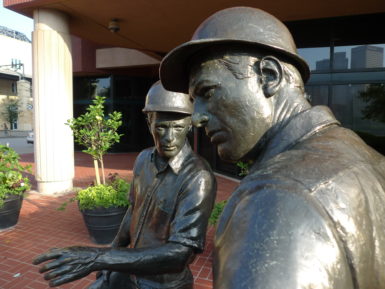Meetings
 Before working with us, many people are unsure as to what to expect of a group meeting or management retreat. Past experience of such meetings has led to unclear, and often low, expectations of a session that will somehow pass over the business issues that the group needs to work on in order to achieve a superficial ‘team-building’ experience.
Before working with us, many people are unsure as to what to expect of a group meeting or management retreat. Past experience of such meetings has led to unclear, and often low, expectations of a session that will somehow pass over the business issues that the group needs to work on in order to achieve a superficial ‘team-building’ experience.
That’s not the impact we want to have and it’s not how we work. This is a brief introduction to how we think about management meetings and what we do to make them as successful as possible. For some of the practical issues of setting up the meeting room that can affect the success of a meeting download the paper Setting up for a Strategy Development Meeting.
What the meeting might be about
Most of the meetings and retreats we design are for two or three days with the evening prior to the first day used to open the agenda. The purpose of such meetings is varied, but generally focuses on one of a range of important issues, such as:
- The business is in competitive crisis and needs coordinated senior effort to turn around.
- The business strategy although successful needs extending
- The development process needs accelerating through concerted attention.
- The senior management group is in conflict about where the business should go & needs to deal with both the conflict and the direction issue.
- The business needs somehow to raise its performance and senior managers need to rethink short- and long-term resource allocations and activities.
There are of course other good reasons to convene a senior group for two or more days, but they are all likely to have either a clear focus on business strategy or on how the senior group is doing its job or both.
Preparation for the session is straightforward. We talk to a cross-section of the participants, (all participants where time and numbers allow), in order to get input about the issues you want to tackle or to form our own ideas of the issues that you might address. These conversations also help us form initial ideas about how the time should be used to achieve your goals. We prefer to talk to people face-to-face where possible but time and logistics often only allow for phone interviews.
After this initial round, and in further discussion with some of the group, we develop an agenda for the meeting which will have a very specific design, but which will be flexible enough to allow for changes once we get started. There are generally several drafts of the agenda before it’s settled. Occasionally, there may be other needs. For instance some of the group, or perhaps an outside speaker may be asked to prepare a presentation on a specific topic. Alternatively, we might ask you to fill out a questionnaire to gather your collective views on a topic to use in the meeting. In all of these instances however, the purpose of the preparation is to introduce new information and ideas that can stimulate the group’s conversation in new ways or to make sure that critical analyses have been done before the group convenes. Aside from that, the only preparation of substance is to make sure that everyone attending the meeting has similar expectations of what they are there to do.
The Meeting itself
The meeting structure and design depends on three key factors:
- The issue the group wants to tackle.
- The size of the group & how well the members know each other.
- The goals of the meeting.
These factors will determine:
- How long the meeting should go;
- How much getting acquainted or conflict management there needs to be;
- What content we need.
Beyond that the variety of activities is infinite, except to say that everything we do will be about either the business issue or the group’s ability to work together. There will be NO generic team-building or leadership or management style activities. The tangible output from the meeting will be plans and assignments for key individuals. We will also transcribe and circulate flipcharts and other product for later use or referral.
Pace & Style
Our characteristic meeting is one that is packed with content, very focused, and hard work for everyone. The intention is to get some tangible product out of all the time and effort everybody puts in and to change the way you think about your business or what you do back in the workplace as soon as possible.
 In order to do this, the pace of the session will vary from bouts of frantic activity to periods of slow, reflective group conversation. We have found that a varied pace not only makes for a more interesting, creative session, but it helps the group discover more of the important issues it needs to deal with. Our working style is to let the group drive the meeting rather than over-direct it. Occasionally, we will push you in a particular direction where we believe there’s an issue that needs deeper exploration or that offers potential insights to the group. This might be an issue involving apparently irreconcilable elements, such as productivity and quality; short term versus long term agendas and so on.
In order to do this, the pace of the session will vary from bouts of frantic activity to periods of slow, reflective group conversation. We have found that a varied pace not only makes for a more interesting, creative session, but it helps the group discover more of the important issues it needs to deal with. Our working style is to let the group drive the meeting rather than over-direct it. Occasionally, we will push you in a particular direction where we believe there’s an issue that needs deeper exploration or that offers potential insights to the group. This might be an issue involving apparently irreconcilable elements, such as productivity and quality; short term versus long term agendas and so on.
Short periods of deep exploration in difficult areas characterize our work and lead, we hope, to some of the most important new thinking for the groups that we work with.
If the meeting goes well the group is often energized around new ideas and plans that it would like to implement back at the office. Too often, though, all the problems that have piled up in your absence obliterate the excitement of the meeting and things that seemed like great ideas at the time, don’t get implemented.
To track this and to follow up on how effective our meeting design was, we generally contract to contact the group, or some part of it, 8-12 weeks after the session. This can take a number of forms, from a brief phone conversation to a formal refresher meeting over one or two days.
Our Aim
Our aim is always to help you deal effectively with what you see as your most pressing business strategy issues. That means we will design an agenda that maximizes the opportunity for the group to work together efficiently and creatively on the issue at hand. This may call for new ways of working for the group.
The most intrusive interventions will only be used where the group can’t get to the business problems at all because there is too much conflict. In that case, brief parts of the agenda might be designed more to increase the performance of the group than to deal directly with the business issue.